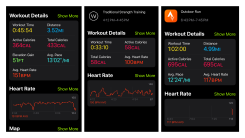Why Apple Fitness Shows You ‘Total Calories’ and ‘Active Calories’

When you track an activity on your Apple Watch, and then go to the Fitness app to see your data, it often gives two different answers to the question “How many calories did I burn?” Those are active calories and total calories, and you may notice that sometimes both fields show the same number, and other times they are two different numbers.
The difference between “active calories” and “total calories” in the Fitness app
You’re probably familiar with the idea that exercise burns calories. We might say, for example, that a half hour jog burns 300 calories. (The exact number will depend on factors like how big you are and how fast you ran, but let’s use this as an example.)
So jogging burns calories, but you still would have burned some calories if you had stayed home watching TV—just not as many. Remember, it takes quite a few calories just to keep your body alive and functioning.
For example, if you weigh 200 pounds, you’ll burn around 46 calories in half an hour of watching TV. (Yes, there is data on this.) Meanwhile, half an hour of easy pace running burns 363 calories. That means you burned 363 total calories, but only 317 of those are on top of what you would have burned staying home.
This is what Apple is trying to communicate with the “active” and “total” calorie labels. To give a real-life example, I went for an easy three-mile jog one day, taking about 38 minutes. Apple reports that I burned 351 total calories, of which 294 were active calories. (That means it thinks I would have burned 57 calories if I hadn’t been running during that time.)
How do we burn calories that are not active calories?
It takes a lot of energy to keep a human body alive! You need to keep your heart beating, your lungs breathing, and your brain thinking. Each cell of your body has to do lots of microscopic maintenance work to stay alive.
This may be a gruesome visual, but think about how a dead body is different from one that’s alive. It stops defending itself against germs and fungi, and begins to fall apart. The reason that doesn’t happen while you’re alive is that your body is constantly working hard to repair damage, attack invaders, and more. And all of that takes energy, which we measure in the form of calories.
I discussed this a bit more in this article on how many calories we burn each day. To give a few examples, a 200-pound, 6’ man would be expected to burn 1,930 calories a day as their basal metabolic rate; a 150-pound, 5’5” woman would burn 1,426. That is before counting any exercise activities or even daily activities like walking around the house and brushing your teeth.
This number, that represents the bare minimum to stay alive, is called your basal metabolic rate, or BMR. Closely related is the resting metabolic rate, or RMR, which includes the energy we use to digest our food. RMR plus the activities we do—such as exercise—equals our total calorie burn for the day.
If you’re curious about your RMR, the Apple Health app includes a number for Resting Energy, which estimates your RMR. Take that number with a grain of salt, though. It’s calculated from your age, sex, and weight, so it’s just an estimate for what a person your size would be expected to burn.
Why are the active and total calorie numbers sometimes the same?
I see different numbers for active and total calories for activities that I logged with the Apple Watch fitness app directly. You know the one—it’s the greenish-yellow icon with the little running person.
But my active and total calories are the same for workouts logged through other apps. Strength training from Whoop? 58 calories active, 58 total. A five-mile run with Strava? 695 active, 695 total. My morning walk, picked up by Oura? 68 active, 68 total.
That’s not because my basal metabolism ceased to activate, it’s just because these apps only communicate a single number to Apple as calorie burn. Since the Apple Fitness app doesn’t know the split, it just reports the same number in both spots.
Which number should I pay attention to, active calories or total calories?
Trick question! Calorie burn, as measured by wearables (any wearables, not just the Apple Watch) isn’t always reliable. So the most correct answer is: neither.
But if you find it helpful to track calorie burn from your wearable, maybe to keep an eye on how much more you should eat if it’s been a high-activity day, the active calories are most useful. To return to the example of my three-mile jog, that jog burned 294 calories over what I would have burned if I hadn’t gone on that jog. So if I want to eat enough to make up for the extra burn, I’d eat the active number of 294 calories, not the total number of 351.



